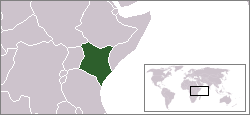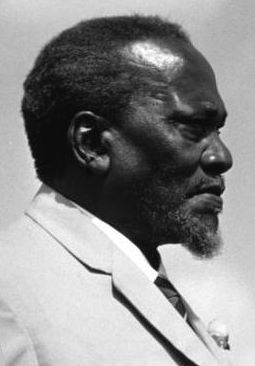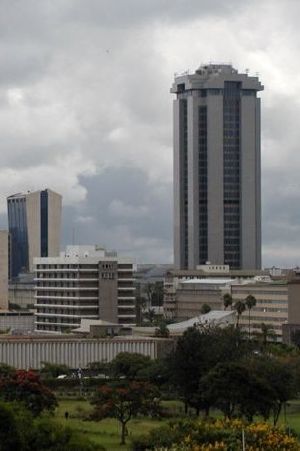Kenya
| Jamhuri ya Kenya Republic of Kenya |
||||||
|---|---|---|---|---|---|---|
|
||||||
| Motto: "Harambee"  (Swahili) "Let us all pull together" |
||||||
| Anthem: Ee Mungu Nguvu Yetu "O God of All Creation" |
||||||
| Capital (and largest city) | Nairobi 1¬į16‚Ä≤S 36¬į48‚Ä≤E | |||||
| Official languages | Swahili, English[1] | |||||
| Demonym | Kenyan | |||||
| Government | Presidential republic | |||||
|  -  | President | William Ruto | ||||
|  -  | Deputy President | Rigathi Gachagua | ||||
| Independence | ||||||
|  -  | from the United Kingdom | 12 December 1963  | ||||
|  -  | Republic declared | 12 December 1964  | ||||
| Area | ||||||
|  -  | Total | 580,367 km² (47th) 224,080 sq mi  |
||||
|  -  | Water (%) | 2.3 | ||||
| Population | ||||||
|  -  | 2022 estimate | 55,864,655[2] (27th) | ||||
|  -  | 2019 census | 47,564,296[3]  | ||||
|  -  | Density | 78/km² (124th) 202/sq mi |
||||
| GDP (PPP) | 2022 estimate | |||||
|  -  | Total | $333.268 billion[4]  | ||||
|  -  | Per capita | $6,061[4]  | ||||
| GDP (nominal) | 2022 estimate | |||||
|  -  | Total | $123.827 billion[4]  | ||||
|  -  | Per capita | $2,252[4]  | ||||
| Gini (2015) | 40.8[5]  | |||||
| Currency | Kenyan shilling (KES) |
|||||
| Time zone | EAT (UTC+3) | |||||
|  -  | Summer (DST) | not observed (UTC+3) | ||||
| Internet TLD | .ke | |||||
| Calling code | [[++254]] | |||||
| 1. According to the CIA, estimates for this country explicitly take into account the effects of mortality due to AIDS; this can result in lower life expectancy, higher infant mortality and death rates, lower population and growth rates, and changes in the distribution of population by age and sex, than would otherwise be expected.[2] | ||||||
Kenya (/ňąk…õnj…ô/; locally [ňąk…õ…≤a]), officially the Republic of Kenya (Swahili: Jamhuri ya Kenya), is a country in East Africa with its capital and largest city in Nairobi. Kenya's territory lies on the equator and overlies the East African Rift, covering a diverse and expansive terrain that extends roughly from Lake Victoria to Lake Turkana (formerly called Lake Rudolf) and further south-east to the Indian Ocean.
Kenya's location on the eastern coast of Africa and central highlands that proved ideal for agriculture have largely dominated its modern history. The Portuguese and then Omani Arabs were the first to establish trading rights along the coast, with slaves among their key exports. British control was initially exerted to stem the slave trade, but the British extended their control to the inland areas, where they overturned the system under which land was held in common by the tribes in order to establish vast plantations. The displaced flocked to the cities, but eventually formed a political movement that led to independence.
Though the government has had periods of one-party rule and been marked by corruption, Kenya has been a relatively stable democracy, with only one coup attempt since its founding.
Geography
Kenya is bordered by Ethiopia to the north, Somalia to the east, Tanzania to the south, Uganda to the west, and Sudan to the northwest, with the Indian Ocean forming the southeast border.
Kenya covers an area of 224,961 sq mi (582,646 sq km). From the coast on the Indian Ocean, the low plains rise to central highlands, which are bisected by the Great Rift Valley; a fertile plateau lies in the west. The Kenyan highlands comprise one of the most successful agricultural production regions in Africa. The highest point in Kenya, Mount Kenya, which reaches 17,057 ft (5,199 m) and features glaciers, is found here.
Kenya has considerable land area for wildlife habitat, including much of the Serengeti plain, where Blue Wildebeest and other bovids participate in a large-scale annual migration. The "Big Five" animals of Africa‚ÄĒthe lion, leopard, buffalo, rhino, and elephant‚ÄĒcan be found in Kenya.
Kenya enjoys a tropical climate. The climate varies from tropical along the coast to arid in the interior. It is hot and humid in the region around Mombasa, with temperatures ranging from 88 ¬įF (31 ¬įC) in the hottest months (January and February) to 80 ¬įF (27 ¬įC) in the cooler months (July through September). The climate is more temperate in the inlands regions around Nairobi, with temperatures from 78 ¬įF (25 ¬įC) to 70 ¬įF (21 ¬įC). Rainfall amounts vary widely, with about 47 inches (1200 mm) annually near the coast, and 10 to 20 inches (500 to 600 mm) inland. The long rainy season lasts from April to June and the short rainy season, from October to December.
History
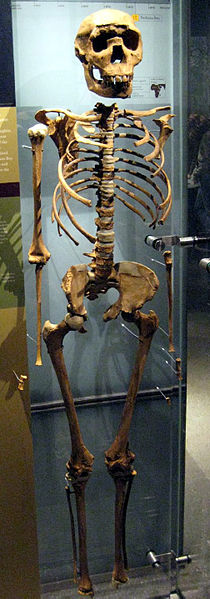
Prehistory
Fossils found in East Africa suggest that protohumans roamed the area more than 20 million years ago. Recent finds near Kenya's Lake Turkana indicate that hominids such as homo habilis and homo erectus are possible direct ancestors of modern Homo sapiens and lived in Kenya during the Pleistocene era.
Colonial history
The Portuguese were the first Europeans to explore Kenya. Vasco da Gama visited Mombasa in 1498, initiating a period of Portuguese rule centered mainly on the coastal strip ranging from Malindi to Mombasa. The western Indian Ocean became a safe haven for Portuguese commercial interests, and all the city-states along the East African coast paid tribute to the Portuguese crown. This policy of extracting tribute was only partially successful, as local East African rulers rebelled frequently against the Portuguese. However, Portuguese naval vessels disrupted commerce within the western Indian Ocean and were able to demand high tariffs on items transported through the sea due to their strategic control of ports and shipping lanes.
Portugal's influence was undercut by British, Dutch, and Omani Arab incursions into the region during the seventeenth century. The Omani Arabs besieged Portuguese fortresses, openly attacked naval vessels, and had completely expelled the Portuguese from the Kenyan and Tanzanian coasts by 1730.
Omani Arab colonization of the Kenyan and Tanzanian coasts brought the once independent city-states under closer foreign domination than during the Portuguese period. Like their predecessors, the Omani Arabs were primarily able to control only the coastal areas, not the interior. However, the creation of clove plantations, intensification of the slave trade, and relocation of the Omani capital to Zanzibar in 1839 had the effect of consolidating Omani power. Arab governance of all the major ports along the East African coast continued until British interests, aimed at ending the slave trade and creating a wage-labor system, began to put pressure on Omani rule. By the late nineteenth century, the slave trade on the open seas had been completely outlawed by the British, and the Omani Arabs were too weak to resist the British navy’s ability to enforce the directive. The Omani presence continued in Zanzibar and Pemba Island (part of the former Zanzibar Sultanate) until the 1964 revolution, but the official Omani Arab presence in Kenya was checked by German and British seizure of key ports and creation of crucial trade alliances with influential local leaders in the 1880s. However, the Omani Arab legacy in East Africa can be seen in their numerous descendants along the coast, who are typically the wealthiest and most politically influential members of the Kenyan coastal community.
Germany established a protectorate over the Sultan of Zanzibar's coastal possessions in 1885. This was followed by the arrival of the Imperial British East Africa Company in 1888. Incipient imperial rivalry was forestalled when Germany handed its coastal holdings to Britain in 1890 after the Kenya-Uganda railway was built. It is believed that the Nandi were the first tribe to be put in a native reserve to stop their attempts to disrupt the building of that railway.
During the early part of the twentieth century, the interior central highlands were settled by British and other European farmers, who became wealthy by farming coffee. By the 1930s, approximately 30,000 settlers lived in the area and exerted undue political power because of their dominance of the economy. The area was already home to over a million members of the Kń©kŇ©yŇ© tribe, most of whom had no land claims in European terms (the land belonged to the ethnic group) and lived as itinerant farmers. To protect their interests, the settlers banned the growing of coffee by the natives, introduced a hut tax, and granted the landless less and less land in exchange for their labor. A massive exodus to the cities ensued.
From October 1952 to December 1959, Kenya was under a state of emergency arising from the Mau Mau rebellion against British rule. The governor requested and obtained British and African troops. The Home Guard, recognized as a branch of the Security Forces, formed the core of the government's anti-Mau Mau strategy as it was composed of loyalist Africans. By the end of the emergency the Home Guard had killed no fewer than 4,686 Mau Mau, amounting to 42 percent of the total insurgents. The capture of Dedan Kimathi in 1956 signified the ultimate defeat of the Mau Mau and essentially ended the military offensive.
Post-colonial history
The first direct elections for Africans to the Legislative Council took place in 1957. Despite British hopes of handing power to "moderate" African rivals, the Kenya African National Union (KANU) of Jomo Kenyatta formed a government shortly before Kenya became independent on December 12, 1963. A year later, Kenyatta became Kenya's first president.
Kenyatta instituted a relatively peaceful land reform; on the other hand, his land policies resulted in deeply entrenched corruption, with choice parcels of land given to his relatives and friends and Kenyatta becoming the nation's largest landowner. Some complained that he favored his tribe, the Kikuyu, to the detriment of the others. He pursued a pro-Western, anti-communist foreign policy. The ensuing stability attracted foreign investment, although Kenyatta's authoritarian policies caused dissent.
At Kenyatta's death in 1978, he was succeeded by Daniel arap Moi, who ran unopposed in one-party elections held in 1979, 1983, and 1988. The 1983 elections were a direct result of an abortive military coup attempt on August 1, 1982. The election held in 1988 saw the advent of a system in which voters lined up behind their favored candidates, instead of a secret ballot. This led to widespread agitation for constitutional reform. Several contentious clauses, including the one allowing only one political party, were changed in the following years. In democratic but flawed multiparty elections in 1992 and 1997, Daniel arap Moi won re-election. In 2002, Moi was constitutionally barred from running, and Mwai Kibaki, running for the opposition coalition National Rainbow Coalition, was elected president. The elections, judged free and fair by local and international observers, marked a turning point in Kenya's democratic evolution.
Politics
Kenya has a presidential system and is a representative democratic republic.The President of Kenya is both head of state and head of government in a multiparty system. Executive power is exercised by the government. Legislative power is vested in both the government and the National Assembly of Kenya. The Judiciary is independent of the executive and the legislature.
Until the unrest occasioned by the disputed election results of December 2007, Kenya had maintained remarkable stability despite changes in its political system and crises in neighboring countries. A cross-party parliamentary reform initiative in the fall of 1997 revised some oppressive laws inherited from the colonial era that had been used to limit freedom of speech and assembly. This improved public freedoms and contributed to generally credible national elections in December 1997.
In December 2002, Kenyans held democratic and open elections, most of which were judged free and fair by international observers. The 2002 elections marked an important turning point in Kenya's democratic evolution in that power was transferred peacefully from the Kenya African Union (KANU), which had ruled the country since independence to the National Rainbow Coalition (Narc), a coalition of political parties. Under the presidency of Mwai Kibaki, the new ruling coalition promised to focus its efforts on generating economic growth, combating corruption, improving education, and rewriting its constitution. A few of these promises have been met. There is free primary education. In 2007, the government issued a statement declaring that from 2008, secondary education would be heavily subsidized, with the government footing all tuition fees.[6]
Disputed 2007 elections
General elections were held on December 27, 2007. In them, President Mwai Kibaki under the Party of National Unity ran for re-election against the main opposition party, the Orange Democratic Movement (ODM). The elections were largely believed to have been flawed with international observers saying that they did not meet regional or international standards, with the tallying process rigged in favor of President Kibaki. After a split which would take a crucial 8 percent of the votes away from the ODM to the newly formed Orange Democratic Movement-Kenya (ODM-K)'s candidate, Kalonzo Musyoka, the race tightened between ODM candidate Raila Odinga and Kibaki. As the count came in to the Kenyan Election Commission, Odinga was shown to have a slight, and then substantial lead. However, as the Electoral Commission of Kenya (ECK) continued to count the votes, Kibaki closed the gap and then overtook his opponent by a substantial margin amid largely substantiated claims of rigging from both sides of the political divide (notably by the European Union observers). This led to protests and riots, open discrediting of the ECK for complicity and to Odinga declaring himself the "people's president" and calling for a recount and for Kibaki to resign. Critics argue that, like his predecessor, Daniel arap Moi, Kibaki manipulates politics to perpetuate his own rule. They maintain that Kibuki has failed to promote genuine democracy and has concentrated more power in the presidency. Kenyan governance remains basically a patrimony, and corruption in government is still widespread. Odinga, in this view, was standing steadfastly against this politics as usual.
The protests escalated into unprecedented violence and destruction of property, leading to Odinga claiming up to 1,000 deaths as a result. The government claimed nearly 700 deaths and the internal displacement of around 260,000 people. A group of eminent persons of Africa, led by former United Nations Secretary General Kofi Annan, was called in to broker a peaceful solution to the political stalemate. This group enjoyed the backing of the UN, European Union, African Union and United States governments, as well as those of various other notable countries across the world. International and local NGOs also met simultaneously, just as the Kenyan parliament was meeting to arrive at a solution, to present principles of good governance to all parties in the election dispute.[7] Later, the work of one of these NGOs, marshaling the power of religion to promote human understanding, would be cited by Mrs. Odinga as key supporters for reconciliation and peace in Kenya.[8]
On February 28, 2008, Kibaki and Odinga signed an agreement on the formation of a coalition government in which Odinga would become Kenya's second prime minister. Under the deal, the president would also appoint cabinet ministers from both PNU and ODM camps depending on each party's strength in Parliament. The agreement stipulated that the cabinet would also include a vice-president and two deputy Prime Ministers. After being debated and passed by Parliament, the coalition would hold until the end of the current Parliament or if either of the parties withdraws from the deal before then.
The new office of the Prime Minister would have power and authority to coordinate and supervise the functions of the government and would be occupied by an elected MP who will also be the leader of the party or coalition with majority members in Parliament. The world watched Annan and his UN-backed panel and African Union chairman Jakaya Kikwete as they brought together the erstwhile rivals to the signing ceremony, beamed live on national TV from the steps of Nairobi's Harambee House. Kenyan lawmakers unanimously approved a power-sharing deal on March 18, 2008, aimed at salvaging a country once seen as one of the most stable and prosperous in Africa. The deal brought Kibaki's PNU and Odinga's ODM together and heralded the formation of the Grand Coalition, in which the two political parties would share power equally.
Grand Coalition
On April 13, 2008, President Kibaki named a grand coalition cabinet of 41 Ministers- including the prime minister and his two deputies. The cabinet, which included 50 Assistant Ministers, was sworn in at the State House in Nairobi on Thursday, 17 April 2008, in the presence of Dr. Kofi Annan and other invited dignitaries.
A constitutional change was considered that would eliminate the position of Prime Minister[9] and simultaneously reduce the powers of the President. A referendum to vote on the proposed constitution was held on August 4, 2010, and the new constitution passed by a wide margin.[10] Among other things, the new constitution delegates more power to local governments and gives Kenyans a bill of rights. It was promulgated on August 27, 2010 at a ceremony in Nairobi's Uhuru Park, accompanied by a 21-gun salute. The event was graced by a number of African leaders and praised by the international community. As of that day, the new constitution heralding the Second Republic came into force.
Under the new constitution, and with President Kibaki prohibited by term limits from running for a third term, Deputy Prime Minister Uhuru Kenyatta, son of Jomo Kenyatta, ran and won with 50.51 percent of the vote in March 2013. He was installed as the fourth President of Kenya on April 9, 2013.
In August 2022, Deputy President William Ruto narrowly won the presidential election, defeating his main rival, Raila Odinga, by a small margin. On September 13, 2022, William Ruto was sworn in as Kenya's fifth president.
Economy
Kenya's main economic strengths include tourism and agriculture. The economy is only now beginning to show some growth after years of stagnation. Some argue that this slow economic growth is because of poor management and uneven commitment to reform; others insist that it is due to falling commodity prices and poor access to Western markets.
In 1993, the government of Kenya implemented a program of economic liberalization and reform that included the removal of import licensing, price controls, and foreign exchange controls. With the support of the World Bank, International Monetary Fund, and other donors, the reforms led to a brief turnaround in economic performance following a period of negative economic growth in the early 1990s. One of the unintended consequences of freeing foreign exchange control was that it allowed a gold-and-diamond export scam, in which the Kenyan government lost over 600 million U.S. dollars. This resulted in a weak currency that hindered economic improvement.
Kenya's gross domestic product grew 5 percent in 1995 and 4 percent in 1996, and inflation remained under control. Growth slowed in 1997 through 1999. Political violence‚ÄĒspecifically, the bombing of the United States Embassy by Al Qaeda in 1998; damaged the tourist industry, and Kenya's Enhanced Structural Adjustment Program lapsed. A new economic team was put in place in 1999 to revitalize the reform effort, strengthen the civil service, and curb corruption, but wary donors continue to question the government's commitment to Western ideas of sound economic policy.
Electricity shortages are considered by some to be long-term barriers to development, together with the government's continued and allegedly inefficient dominance of key sectors, corruption, the foreign debt burden, unstable international commodity prices, a poor communication infrastructure, and the impact of HIV/AIDS. The effect of HIV/AIDS, which is particularly hitting the most productive sector of the population, has largely offset the previous gains in population growth resulting from a high birthrate and reduced infant mortality due to better health care.
Chief among Kenya's exports are flowers (horticulture), fruits and vegetables, tea, and coffee. Another key foreign exchange earner is tourism, which has grown tremendously since 2003.
Demographics
Kenya is a country of great ethnic diversity. Tension between the various groups accounts for many of Kenya's problems. The ethnic groups represented in Kenya include Kń©kŇ©yŇ©, Luhya, Luo, Kalenjin, Kamba, Kisii, Ameru, as well as other African identities and a small number of others.
The majority of Kenyans are Christian: various Protestant churches as well as Roman Catholics. Other religious affiliations include Muslim, traditional religions, as well as Hinduism, Jainism, and the Bahá'í Faith.
Culture
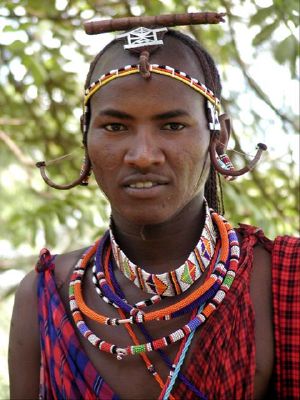
Kenya is a diverse country, with many different cultures represented. Notable cultures include the Swahili on the coast and the pastoralist communities in the north. The Maasai culture is the best known.
National dress
In an effort to unify the country, political leaders are attempting to implement a national dress code. However, due to the great cultural diversity, many groups have had no role in the planning or implementation of this proposal, and therefore feel disenfranchised. Some common dress pieces include the Kanga (traditionally from the coastal regions of the country) and the Kitenge, loose fitting tunics worn by men and women. The Kanga is a piece of cloth that is screen printed with beautiful sayings in Kiswahili (or English) and largely worn by women around the waist and torso. Kangas are used in many ways, such as aprons, child-carrying slings, picnic blankets, and swimwear.
Music
Kenya is home to a diverse range of music styles, ranging from imported popular music to traditional folk songs. The guitar is the most popular instrument in Kenyan music, and songs often feature intricate guitar rhythms. The most famous guitarist of the early 20th century was Fundi Konde.
Modern popular music can be divided into two genres: the Swahili sound and the Congolese sound. There are varying regional styles, and performers often create tourist-oriented "hotel pop" that is similar to Western music.
Sports
Several sports are widely popular in Kenya, among them football (soccer), cricket, and boxing. But Kenya is known chiefly for its dominance in cross country and the marathon, middle and long-distance running. Kenya has regularly produced champions in various distance events. Lately, there has been controversy in Kenyan athletic circles, with the defection of a number of Kenyan athletes to represent other countries, chiefly Bahrain and Qatar. The Kenyan Ministry of Sports has tried to stop the defections, but they have continued, with Bernard Lagat, for example, choosing to represent the United States. Kenya is now also beginning to be a force to reckon with in rugby.
Film and theater
The country offers spectacular scenery and can only be compared to South Africa in regard to producing some of the most talented actors and actresses on the African continent. Due to the government's nonchalant attitude, the film industry has remained dormant. One exception was the award-winning The Constant Gardener. Television has proved popular with the Kenyan audience and has been around since the 1960s. Serious television drama was witnessed for the first time in the early 1990s. A new genre in the form of stand-up comedy followed with the entry of the group, "Redikyulas" comprised of a trio of young comedians who specialized in political satire. They poked fun not only at the establishment but also at the then Kenyan president, Daniel arap Moi. This was hitherto unheard of and could have led to prosecution of the artists had it occurred a few years earlier.
Notes
- ‚ÜĎ Constitution (2009) Art. 7 [National, official and other languages] "(1) The national language of the Republic is Kiswahili. (2) The official languages of the Republic are Kiswahili and English. (3) The State shall‚Äď-‚Äď- (a) promote and protect the diversity of language of the people of Kenya; and (b) promote the development and use of indigenous languages, Kenyan Sign language, Braille and other communication formats and technologies accessible to persons with disabilities."
- ‚ÜĎ 2.0 2.1 CIA, Kenya World Factbook. Retrieved July 26, 2022.
- ‚ÜĎ Kenya Population and Housing Census 2019 GHDx. Retrieved July 26, 2022.
- ‚ÜĎ 4.0 4.1 4.2 4.3 Report for Selected Countries and Subjects (valuation of Kenya GDP) International Monetary Fund. Retrieved July 26, 2022.
- ‚ÜĎ Gini index The World Bank. Retrieved July 26, 2022.
- ‚ÜĎ [http:http://news.bbc.co.uk/1/hi/world/africa/7239577.stm Free secondary schools for Kenya] BBC News, February 11, 2008. Retrieved July 26, 2022.
- ‚ÜĎ Frederick Wakhisi, A Day for Peace in Kenya Universal Peace Federation, March 19, 2008. Retrieved July 26, 2022.
- ‚ÜĎ Ida Odinga, I. Odinga: The Beauty of Diversity Universal Peace Federation, January 30, 2009. Retrieved July 26, 2022.
- ‚ÜĎ Kenya MPs opt to scrap prime minister position BBC News, January 28, 2010. Retrieved July 26, 2022.
- ‚ÜĎ Kenyans back change to constitution in referendum BBC News, August 5, 2010. Retrieved July 26, 2022.
ReferencesISBN links support NWE through referral fees
- Barsby, Jane. Kenya - Culture Smart!: the essential guide to customs & culture. Kuperard, 2007. ISBN 978-1857333497
- Branch, Daniel. Kenya: Between Hope and Despair, 1963-2011. Yale University Press, 2011. ISBN 978-0300148763
- Hornsby, Charles. Kenya: A History Since Independence. I. B. Tauris, 2013. ISBN 978-1848858862
- Kenyatta, Jomo. Facing Mount Kenya. Vintage, 1962. ISBN 978-0394702100
External links
All links retrieved March 2, 2025.
- Kenya Country Profile BBC
- Kenya CIA World Factbook
- Kenya US State Department
- Kenya The Guardian
- Kenya Airways
Credits
New World Encyclopedia writers and editors rewrote and completed the Wikipedia article in accordance with New World Encyclopedia standards. This article abides by terms of the Creative Commons CC-by-sa 3.0 License (CC-by-sa), which may be used and disseminated with proper attribution. Credit is due under the terms of this license that can reference both the New World Encyclopedia contributors and the selfless volunteer contributors of the Wikimedia Foundation. To cite this article click here for a list of acceptable citing formats.The history of earlier contributions by wikipedians is accessible to researchers here:
The history of this article since it was imported to New World Encyclopedia:
Note: Some restrictions may apply to use of individual images which are separately licensed.


